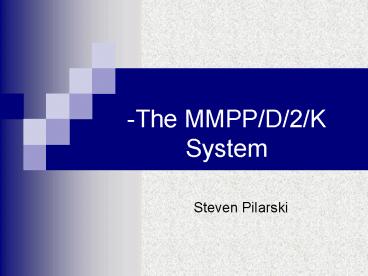-The MMPP/D/2/K System - PowerPoint PPT Presentation
1 / 10
Title:
-The MMPP/D/2/K System
Description:
Own results of the MMPP system computed with Sharpe. Conclusion. References. 3 /10 ... http://www.ee.duke.edu/~chirel/IRISA/sharpeGui.html. Danamics ... – PowerPoint PPT presentation
Number of Views:11
Avg rating:3.0/5.0
Title: -The MMPP/D/2/K System
1
-The MMPP/D/2/K System
- Steven Pilarski
2
Contents
- Introduction
- Examples for source modelling with Petri Nets
- The MMPP/D/2/K system
- How it works
- Token game with Danamics
- Important performance results
- Own results of the MMPP system computed with
Sharpe - Conclusion
- References
3
Source Models with Petri Nets
- Some examples
- Poisson source
- (Markov)1
- ON/OFF source
- (IPP)2
1,2 Stochastische Netze 1, Prof.Dr.
Müller-Clostermann (http//www.informatik.uni-esse
n.de/SysMod/lehre/SN/)
4
MMPP/D/2/K Model as a DSPN
Source
Buffer/Mux
Operators
http//www.dspnexpress.de/
5
Values
- Given
- Duration of bursty mode and normal mode are
- Average arrival rate
- Searched
- With these values and a burst factor B we can
compute the necessary ?s (Bursty_Arrival and
Normal_Arrival)
6
Some Performance Results
- It is interesting to see how the loss probability
behaves when the buffer size or/and burst factor
are increasing/decreasing
3,4 Thümler, Axel Stochastic Modeling and
Analysis of 3G Mobile Communication Systems
(http//eldorado.uni-dortmund.de8080/FB4/ls4/fors
chung/2003/Thuemmler/Thuemmlerunt.pdf
7
Some Sharpe results (1)
- Restrictions
- With Sharpe it is not possible to model
deterministic SPNs (only GSPNs), beause of that
the service rates are neg.ex. distributed
Burst_Factor Loss_Probability bei K100 Loss_Probability K200 Loss_Probability K300 Loss_Probability K500
B1 0 0 0 0
B10 0 0 0 0
B25 1,36E-09 0 0 0
B50 0,00000061 3,6E-11 0 0
B100 0,0000338 0,000000152 6E-10 0
B200 0,000276 0,00000845 0,00000026 2,45E-10
B300 0,00052 0,0000301 0,00000185 6,7E-09
8
Some Sharpe results (2)-Burst Factor vs. Buffer
Size
Loss Probability
Burst Factor
9
Conclusion
- Burst traffic influences loss probability
enormously - Big buffers can help to avoid these problems, but
they (can) offer other problems too - Increasing of Jitter and End-to-End delay
(important for VoIP e.g.) - Buffers are expensive
- Fast memory is necessary
- Queuing algorithms are complex, particularly if
priorities have to be implemented (e.g. Fair
Queuing, Loss Priorities) - But without or too little buffer, packet loss can
grow about all limits and service level
agreements are hard to keep - E.g. Typical values for cell loss in ATM are in
the range of 10-8 to 10-10!!
10
References
- MMPP/D/2/K System
- http//mobicom.cs.uni-dortmund.de/gsmp/DSPN/mmppd2
k/mmppd2k.html - Thümmler, Axel
- Stochastic Modeling and Analysis of 3G Mobile
Communication Systems (http//eldorado.uni-dortmu
nd.de8080/FB4/ls4/forschung/2003/Thuemmler/Thuemm
lerunt.pdf) - Müller-Clostermann, Bruno
- Stochstische Netze 1, Modelle der Informatik
(http//www.informatik.uni-essen.de/SysMod/lehre/i
ndex.html) - Rathgeb, Erwin
- Hochgeschwindigkeitsnetze (http//tdrwww.exp-math.
uni-essen.de/index2.php) - Sharpe
- http//www.ee.duke.edu/chirel/IRISA/sharpeGui.htm
l - Danamics
- http//www.cs.uct.ac.za/Research/DNA/DaNAMiCS/































